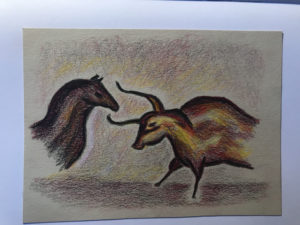
The Prehistoric Primary Colors
The Prehistoric Primary Colors
by Alison Hazel

The earliest remaining prehistoric art that early humans created can be seen in the caves at the town of Lascaux in France.
There are other areas in the world with palaeolithic art, but the Lascaux caves are famous for their color, variety and volume of images.

In this sketch, I tried to recreate the image of the bull and horse from the cave art at Lascaux.
I used toned paper and the prehistoric primary colors of black, white and red.
I also added some yellow as that was available from burnt umber.
Cave Art
Below is a photo from the caves and you can see the power of the red used.
The early artists made use of the natural bulges, cracks and protuberances of the cave walls to add almost a relief effect to each animal.

Modern Primary Colors
The modern primary colors are red, yellow and blue.
When mixed in varying degrees you can make all the colors.
Prehistoric Primary Colors
The prehistoric primary colors are commonly known as black, white and red.
The term “Prehistoric Primaries” is one way to express that the early cave painters only had a few natural colors at their disposal.

Limited Palettes
To use a limited palette in art means to only draw or paint with a few colors.
The most limited palette is black and white such as is seen in pen and ink drawings.

If you add one more color to black and white, such as the cave painters adding red, you can create dynamic images where color is handled carefully to express the meaning of the art piece.
Using a limited palette is a good way to bring focus to your artworks and set the mood for individual paintings.
Your Paint Box
In a beginner’s paintbox of say, twelve colours, there is the tendency to dip into each and every color pan available.

If you bring some discipline to your color palette you can explore your color techniques and learn a great deal about working with color as you create sophisticated artworks.



